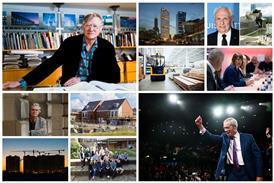Mary Richardson went to meet a group of young people in Colchester whose ‘inspirational’ input is helping shape the design of a new garden village. They spoke about the innovative ways they are being empowered to contribute to this new community with support from young peoples’ placemaking champions MATT+FIONA.
MATT+FIONA is a social enterprise run by architect Matt Springett and architect/educator Fiona MacDonald. Their approach to involving young people in placemaking is one that offers lessons for anyone looking to move beyond a tokenistic, after-the-fact ‘community consultation’ model.
Since 2016, the duo’s organisation has been developing new ways to help young people have a meaningful say in decisions about the built environment. Believing ‘children and young people have something to offer, and to learn, at every stage of the process of making buildings and shaping places’, they have developed signature working methods: ‘Build’, ‘Learn’, and – as exemplified here – ‘Connect’, an engagement programme designed to embed young people’s ideas into the design process.

Springett says, “What I find so inspiring about the conversation here is that it started even before the designers were on board. It helped shaped the brief. Consultation is often a performative thing that happens after the decisions have been made. This isn’t like that.”
Tendring Colchester Borders Garden Community
Tendring Colchester Borders Garden Community is a 7,500+ home scheme from Latimer, development arm of Clarion Housing Association. Latimer has selected a team led by RIBA Stirling Prize winners Haworth Tompkins to serve as masterplanners.

Haworth Tompkins will collaborate with Swedish masterplanners Kjellander Sjöberg, spatial and landscape design practice Periscope, emerging architecture firm Grounded Practice, engineers Arup, and Michael Pawlyn’s regenerative design studio Exploration Architecture.
Jointly commissioned by Colchester, Tendring and Essex Councils, the development will sit on a 715Ha site east of Colchester, near the University of Essex. One of 43 schemes in the government’s Garden Communities programme, the aim is to create an attractive, ultra-sustainable, low-car-use community that avoids the pitfalls of so many recent large housing developments.
Young people’s input
MATT+FIONA facilitator George Pope has run holiday design workshops, and a design competition for local schools with an exhibition showcasing the children’s ideas for the new community. Key preferences emerging from the submissions were: nature-based solutions, spaces for young people, rewilding, dark-sky community principles, and connections to water.
Young people’s forum

A young people’s forum has also been established. Now self-titled ‘Essex Young Designers’, this 14-member group has been meeting monthly to review the proposed design of the community and feedback directly to the design team. Funding from Latimer has enabled the MATT+FIONA team to work with the group for over a year, and this has proved particularly satisfying for the team, who have loved watching the young people grow in skills, knowledge and confidence.
Matt says, “I think this group is an example of good practice for other communities being built. It might require some investment, but it’s worth it because it makes for a happier and healthier community in the end.”
Feeding into the designs
This is meaningful, early-stage consultation with a demographic quite different from the ‘usual suspects’ drawn to planning consultations. The core group of teenagers are paid for their participation. George explains how the process works, “A typical session for the group might begin with a presentation from the designers on a specific aspect of their work. Then there would be a chance for the young people to feedback on this topic, either reviewing drawings or design codes.
“Then the second half of the session would be more propositional, asking them to take part of the design brief and come up with their own ideas. Discussions, designs and feedback are compiled into a report after each session, which is shared with the client and design team.”
BD met Frankie (16), Amber (15) and Rihanna (18) three members of the group, who, thanks to this client-side willingness to treat their ideas seriously, have been able to have a real impact on designs and plan. All of them expressed how much they value the opportunity to explore their creativity in an environment where there is no predetermined outcome. Their appreciation of the built environment has increased too. Frankie says, “I’ll go to London for an architecture walk now rather than just out to the park.”
Lived experience
Meanwhile, the sessions have turned some of them into more critical thinkers, who ask more challenging questions about the places where they live. Says Rihanna, “The session on civic centres changed my view of my town centre massively. I thought, ‘Wow, this place now looks so dangerous.’” She shared her experiences of the problems she and her friends have had finding places to hang out together. It is examples of lived experience like this that are proving so valuable to the Latimer team.
Young people’s contribution
Springett says the young people don’t just have an eye for issues affecting their age group, he is consistently impressed by the empathy demonstrated by the teenagers, and their concern for the needs of marginalised groups.
What do the teenagers themselves think is special about the contribution they make? Frankie says, “An open and fresh mind. We haven’t been through training or things like that, which condition you to think, ‘This is how things are. This is how things work. We’ll stick to this.’ So, we’re able to push the boundaries.”
Rihanna agrees, “We’re still quite imaginative. We have different ideas adults might not think of.” She continues, “I’m excited to have a real impact on the future, for any children I have and those of my friends and family. Knowing I can have an input on that is really special.”
Rubble Garden
The Young Designers group has built a close relationship with nearby Beth Chatto’s Plants and Gardens. They have designed installations that are being shown there over the summer, and have now cooperated with the Beth Chatto team on a rubble garden that has just opened in a “meanwhile space” next to FirstSite in Colchester.
Young people are optimists
Russ Edwards, Latimer Project Director for the new community, is enthusiastic about the young people’s contribution. He says, “Latimer has consciously placed young people at the heart of our new garden community project. We don’t think about this as a 25-year project, or even a 125-year project.
“It’s about establishing a new place many generations will call home. In this context, we recognised very early – before even appointing our consultant team – that young people needed to be engaged in shaping the sort of community that they want to live and work in… and their input has been nothing sort of inspirational.
“Young people are optimists, altruists, and environmentalists – and they have a critical role in holding our consultant team and ourselves to account in delivering a place that meets their expectations. If some of our Essex Young Designers make this place their home in a few years, I hope they, their children, and their grandchildren will be proud of their role in shaping it.”
Changed lives
The plan for the new community is currently being examined in public. It has been shaped for the better by the contribution of the young consultees. And their lives have been changed for the better by their involvement. Amber says, “I’ve been watching architecture programmes since I was seven – and this has really cemented for me how much I want to do that in the future.”
Frankie agrees: “It’s swayed my career and education choices. I’ve looked for university openings for engineering – it’s changed the plan of my life, as dramatic as that sounds.” Rihanna meanwhile already has an offer to study architecture at university.
At a time when there is often perceived to be a battle in the housing realm between the vested interests of older generations and the needs of the young, this kind of work seems vital. Just don’t ask the kids what they think about e-scooters as a transport option, if you don’t want to hear their answers…
>> Also read: Why we need foundational change in how we engage young people with the built environment
>> Also read: Boomers to Zoomers: Designing for the Generations
Boomers to Zoomers: Designing for the Generations

Building Design has launched a campaign focused on different intergenerational design needs.
Boomers to Zoomers will in the coming months look at the underlying challenges we face in designing for different generations. It aims to highlight the need for architectural solutions that cater to all age groups.
The campaign will focus on a range of topics including designing for children and young people, intergenerational living and new models for housing, workplace issues, later-living and education and skills.
Email us at ben.flatman@bdonline.co.uk or use the hashtag #boomerstozoomers
BD’s campaign is being guided by an editorial panel, drawing on expert advisers from across architecture, planning and urban design.
The editorial panel includes:
- Dinah Bornat, founding co-director of ZCD Architects
- Alex Ely, founding director of Mae Architects
- Darryl Chen, partner at Hawkins Brown
- Satish Jassal, founding director of Satish Jassal Architects
- Kathy MacEwen, independent planning consultant and former head of planning and enabling at CABE
- Anna Mansfield, director at Publica
- Setareh Neshati, head of development at Westminster City Council
- Sarah Robinson, associate director at The King’s Foundation
- Peter Sofoluke, director at BPTW architects
Click here to find out more.


































No comments yet